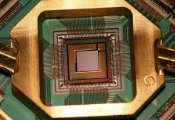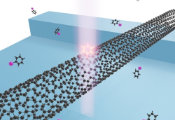Over $7.4 Million Awarded to INRS to Revolutionize Quantum Technology
July 24, 2024 -- Three promising projects led by INRS professors will receive $7.4 million in funding over the next few years. These initiatives aim to enhance quantum communication, computing, and sensing capabilities by integrating photonics and quantum technologies. The projects, all of which are university-industry partnerships, will be funded by the Natural Sciences and Engineering Research Council of Canada (NSERC) through its Alliance Advantage grants program.
In recent years, there has been growing worldwide interest in the potential power of quantum devices. Pushing the limits of quantum science and technology promises unparalleled answers to many of society’s future challenges. The Quebec government has prioritized the sector in its Quebec Research and Innovation Investment Strategy (SQRI), and Canada has a national strategy for quantum technologies.
Equipment for the internet of the future
The “Scalable solid-state semiconductor platform for on-chip quantum communication” project will receive a grant of $1,170,000 over four years. Along with colleagues from McGill University and Polytechnique Montréal, the project is led by EMT Research Centre Professor Sharif Sadaf, nanophotonics specialist and holder of the Canada Research Chair in III-nitride Compound Semiconductor Nanostructures and Devices. The team’s goal is to develop a platform of semiconductors called epitaxial quantum dots (QDs) for efficient quantum light generation. These cutting-edge semiconductors will make it possible to generate and manipulate quantum photon states.
Known as single-photon sources (SPS) and capable of emitting one photon at a time on demand, these kinds of devices are the basis for many quantum technologies, such as quantum communication, quantum computing, and quantum sensing. The platform that Professor Sadaf and his colleagues aim to develop will be based on III-nitrides, whose quantum emission properties have been shown to be adjustable and controllable over a broad spectrum as well as at room temperature. This characteristic makes for a plethora of potential applications, particularly in terms of creating future electronics and optoelectronics technologies, including computer hardware, and developing next-generation on-chip quantum communication linked to the internet of the future.
In addition to the aforementioned educational institutions, four industrial partners will be working closely on the project: Xanadu, CMC Microsystems, OptoElectronic Components, and Numana, all of which are already active in quantum sector commercialization. According to Professor Sadaf, the multidisciplinary project is enormously important for quantum science and technology. “Reaching our goal promises to bring about a major paradigm shift in the field in Canada and around the world,” he emphasizes.
Improving cybersecurity and biomedicine
EMT Research Centre Professor Roberto Morandotti, nonlinear optics specialist and holder of the Canada Research Chair in Smart Programmable Photonics, is heading up the “Advanced QUAntum applications via complex states in integrated and meta optics (AQUA)” project. It will receive $4,998,882 over five years. Four other EMT professors are co-directing: Sharif Sadaf, José Azaña, Luca Razzari, and Bienvenu Ndagano.
The AQUA project aims to develop and commercialize quantum communication, imaging, and sensing technologies based on integrated photonic processing platforms and techniques. These technologies are expected to be scalable and far more energy-efficient than those currently known. They involve high-throughput, high-bandwidth, multi-user quantum communication networks, nanostructured metamaterials for advanced quantum imaging, and innovative quantum sensing and imaging techniques based on terahertz radiation, meta-optics, and single-photon cameras.
Collaborators include McGill University, the University of Toronto, the University of Alberta, Université de Sherbrooke, and Swinburne University of Technology, in addition to the following industrial partners: CMC Microsystems, COMBS, Enablence, few-cycle Inc., Ki3 Photonics Technologies, OptoElectronic Components, Pasqal, SpectraCann, and Xanadu Quantum Technologies.
Unrivalled communications power
Lastly, the “High-dimensional photonic systems for quantum information processing” project has received funding totalling $1,275,000 over four years. It is also under the direction of Roberto Morandotti, in collaboration with EMT Research Centre Professor José Azaña, who held the Canada Research Chair in Ultrafast Photonic Signal Processing until 2021.
The project’s industrial partners are Ki3 Photonics Technologies and OptoElectronic Components, which specialize in quantum technology innovation and commercialization. Supported by a complementary grant from PRIMA Québec (the Advanced Materials Research and Innovation hub), the group’s work aims to demonstrate the feasibility of quantum internet.
To achieve this, Professors Morandotti and Azaña and their team intend to develop and commercialize a scalable quantum photonic processor based on complex photonic states. Their aim is to implement high-dimensional quantum computing operations and algorithms and set up a test bed for secure quantum communication over fibre-optic links.
These research efforts will also be an excellent opportunity to equip highly qualified emerging researchers with cutting-edge knowledge in quantum photonic computing, quantum communications, and quantum internet.




































